Introduction: The End of an Ancient Rivalry
In 146 BC, after more than a century of intermittent conflict, Rome extinguished its greatest rival. The final siege and destruction of Carthage marked the culmination of the Third Punic War and the total annihilation of a once-mighty empire. Leading the charge was Scipio Aemilianus, grandson by adoption of Scipio Africanus, the hero of the Second Punic War. What unfolded under his command was not merely military conquest—it was the calculated erasure of a civilization.
The Legacy of the Punic Wars
Rome and Carthage had clashed in three titanic wars between 264 and 146 BC. The First Punic War brought Sicily into Roman hands. The Second, with Hannibal’s dramatic campaign, saw the near-collapse of Rome before its eventual triumph at Zama. The Third War, driven by Roman fear, ambition, and revenge, was far shorter but far more brutal. By the mid-2nd century BC, Carthage had recovered economically, but its political subservience to Rome left it vulnerable to provocation and pretext for war.
Scipio Aemilianus: Inheritor of a Legacy
Scipio Aemilianus, an experienced commander and respected statesman, was elected consul in 147 BC despite being underage by traditional standards—his appointment was a sign of both political confidence and desperation. The Roman Senate needed results. Scipio reorganized the demoralized Roman forces and prepared for a final, methodical assault on Carthage.
The Siege of Carthage
The siege had begun in 149 BC, but Roman progress was slow. Carthage, though weakened, mounted a fierce resistance. Its citizens transformed into soldiers; even women and slaves took up arms. The city’s formidable triple walls and harbor defenses defied conventional assault. But under Scipio’s relentless command, the Romans tightened their grip—cutting off supplies, breaching outer defenses, and slowly advancing street by street.
The Final Assault and Destruction
In the spring of 146 BC, Roman forces broke through the final Carthaginian defenses. The fighting turned into urban warfare—bloody, personal, and apocalyptic. Carthaginian resistance lasted for six days. When the citadel on the Byrsa hill finally fell, Scipio ordered the city burned. Temples, libraries, and homes were reduced to ash. Survivors—perhaps 50,000—were sold into slavery. According to later accounts, Scipio wept amid the ruins, quoting Homer: “A day will come when sacred Troy shall perish.”
Rome’s Message to the World
The destruction of Carthage sent a clear signal: Rome would not tolerate rivals. The city’s ruins were cursed, its memory condemned. Whether or not the infamous salting of the earth actually occurred, the symbolism was clear. Carthage was wiped from the map, and the province of Africa was born in its place—Rome’s new breadbasket and strategic jewel.
Aftermath and Historical Memory
Scipio returned to Rome a hero, celebrated with a triumph. Yet the obliteration of Carthage left an enduring scar on Roman identity. The totality of the destruction shocked even some contemporaries and would later fuel debates about Roman morality, imperialism, and justice. Cato the Elder, who had relentlessly pushed for war with the phrase “Carthago delenda est,” had seen his wish fulfilled—but at what cost to the Roman soul?
Conclusion: Ashes and Empire
In 146 BC, on the shores of North Africa, Scipio Aemilianus brought an end to Carthage. The victory was total, the devastation near absolute. But in doing so, Rome crossed a threshold—into empire, into dominance, and into a new age of self-assured brutality. The fall of Carthage was not just the end of a city, but the birth of a Roman century defined by conquest, pragmatism, and the belief in eternal supremacy. From the ashes of Carthage, an empire without equal rose.






